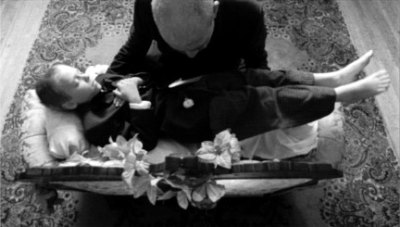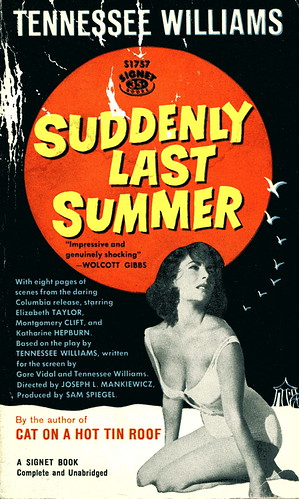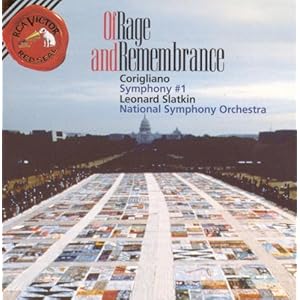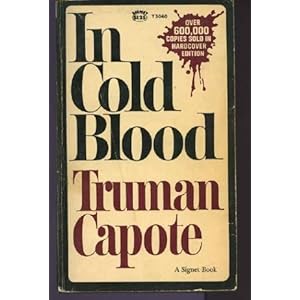
by Christopher Conlon
Here’s what I don’t like about most of what’s marketed today as “horror.”
It isn’t scary.
Very little of it is even interesting. Silly stories about psycho killers lurking in the dark or icky monsters preoccupied with tearing off the bikini tops of nubile young ladies...who cares? Such things are fine for entertainment, but the “horror” label would seem to suggest works that are supposed to be, well, horrifying. Disturbing. Unsettling.
Yet I’ve often found that a lot of the most disturbing material out there isn’t marketed as “horror” at all.
Here are five of my favorite horrors—horrors that aren’t labeled “horror.”

1. Wisconsin Death Trip (1999)
Directed by James Marsh. From the book by Michael Lesy.
Wisconsin Death Trip presents a challenge for anyone trying to write about it—the film is almost literally indescribable. It’s a black-and-white documentary, or docudrama, focusing on the bizarre events which took place in Black River Falls, a small, poverty-stricken town in Wisconsin at the end of the 19th century. Using actual photographs from the period as well as silent reenactments (the film has no dialogue, only narration by Ian Holm and an evocative music score), Wisconsin Death Trip takes us deep into a particular heart of darkness, through accounts of actual events recorded by the local newspaper of the time. There are reports of murder and suicide; ghostly hauntings; premature burials; outlaws and arsonists.

Most memorable, perhaps, are the whispered real-life reports from the Mendota Asylum for the Insane, chronicling the various manias of the residents there. Throughout, the elegant black-and-white historical sections are contrasted with full color segments depicting contemporary life in Black River Falls—very different, and yet in some ways oddly the same. This is a truly frightening film, yet powerfully moving at the same time. It’s available on DVD, with a fascinating director’s commentary and behind-the-scenes documentary. (Michael Lesy’s book—about the same time and place, but a very different kind of experience—is also highly recommended.)

2. Suddenly Last Summer (1958). A Play by Tennessee Williams.
Violet Venable, aging matriarch of the Venable family of New Orleans, has a problem. Her beloved (perhaps too beloved) son Sebastian has died suddenly during a European trip, and the cousin who accompanied him there, Catharine Holly, has come home with a wild story of how it happened—a story so horrific that Violet has summoned a doctor to examine her niece with an eye toward having the girl subjected to a lobotomy. (Williams’ own sister, Rose, was lobotomized in 1943.) What happened to Sebastian at Cabeza de Lobo? And why is Violet so desperate to have Catherine’s story disappear that she bribes the doctor with promises of hefty donations to his hospital if only he’ll “cut that hideous story out of her brain”? Suddenly Last Summer is a modern Grand Guignol featuring, among other tasty themes, mental illness, cannibalism, the sexual exploitation of children, and, of course, lobotomies.

As one reader writes online, “This play is really really gross.” It is. But it’s also staggeringly powerful, with some of Williams’ most poetically beautiful language. You will never forget Catharine’s climactic monologue—that’s a personal guarantee. The script for Suddenly Last Summer is available in the omnibus collection Tennessee Williams: Four Plays, and a fine production from 1993 can be had on DVD in the BBC’s Maggie Smith Collection. (The feature film of Summer, starring Katharine Hepburn and Elizabeth Taylor, is a much-expanded—not by Williams—version that has its merits, but shouldn’t be confused with the original.)

3. The Artwork of Matt Sesow (ongoing)
I’ll say this up front, and I’ll brook no argument: artist Matt Sesow is a genius, one of the finest “underground” painters this country has. (You may have seen his work on the cover of my collection Starkweather Dreams, or on Mike Arnzen’s 100 Jolts.) Sesow is a D.C.-area artist who lost his dominant hand in an accident when he was a child; he had to re-learn how to do everything with his other hand, including drawing and painting. The result is an art totally unlike anything else I’ve ever seen. Looking at a Sesow painting seems to me the psychological equivalent of looking at one of those “Anatomical Man” transparent figures in which you can see every muscle and nerve in the human body.



Sesow’s faces are stylized, exaggerated, grotesque—and yet, as with all great art, the distortion is there for a purpose. When we look at a great Sesow painting we’re looking not at the face someone shows the world, but at their inner life, their loves and hatreds, their jealousies and joys, their childish rages and Dionysian hidden selves. In that way he’s like Picasso, but Picasso only rarely reached the level of nightmare depicted in a lot of Sesow’s canvases. He’s not just horrific—Sesow’s paintings can be damned funny, too—but for the most part a tour through Matt Sesow’s work is like a tour through the faces of Hell. An enormous amount of Sesow can be found at his website: http://sesow.com. Take a look. Better yet, consider purchasing one of his many pieces. They’re reasonably priced and really should be on the wall of every horrorhead’s home.

4. Symphony No. 1 by John Corigliano (1991).
I know, I know—a symphony on a horror list? But this isn’t just any symphony. The composer, John Corigliano, has dabbled in film scores—he wrote the astonishing score to Ken Russell’s Altered States (1980)—and much of his Symphony No. 1 sounds as if it’s a score to the greatest horror film never made. In fact, the music does derive from a kind of horror—in this case, the horror of AIDS. “During the past decade,” Corigliano wrote in 1991, “I have lost many friends and colleagues to the AIDS epidemic...My First Symphony was generated by feelings of loss, anger, and frustration.” The key word there is “anger”—in fact, the first movement of the symphony is subtitled “Of Rage and Remembrance.”

A great deal of this large-scale symphony is loud, angry, ugly music, filled with crashing timpani and blasting brass, and it’s not necessarily pleasant to listen to. But the themes are easy to follow, and the attentive listener is pulled irresistibly into Corigliano’s rage and pain. If your idea of classical music goes no farther than Beethoven’s Fifth Symphony and the soundtrack to Amadeus, then Corigliano’s Symphony No. 1 is probably not for you. But for the more adventurous listener, someone who can handle, say, Stravinsky and Bartok, this symphony is an unforgettable experience. John Corigliano’s Symphony No. 1 is available on CD in several different versions.
Sample: http://www.amazon.com/gp/product/B0013AH202/ref=dm_mu_dp_trk2

5. In Cold Blood (1966) by Truman Capote.
This may be the single work on the list that’s most familiar to horrorheads, at least by reputation. In Cold Blood chronicles the lives and deaths of six people whose existences intersected one night in 1959 in Holcomb, Kansas—the Clutter family (Herbert and Bonnie and their children Nancy and Kenyon), who were murdered in their home, and Perry Smith and Dick Hickock, who murdered them. Capote spent several years researching the case, getting to know people in Holcomb—and, eventually, getting to know the killers after they were placed on Death Row.

Capote’s “nonfiction novel” (based strictly on research, but with some invented dialogue and interior monologue) unfolds like a Greek tragedy, at its own stately pace; by the end we know both the victims and the perpetrators nearly as intimately as we know people in our own lives. The book has been filmed twice, most effectively by Richard Brooks in 1967; then there is, of course, the movie Capote, starring Oscar-winner Phillip Seymour Hoffman, which details Capote’s writing of the book. (Fans of Capote would do well, by the way, to check out the lesser-known Infamous, a film starring Toby Jones which covers the exact same material but in a strikingly different way.) But no film can compare with the experience of reading In Cold Blood, the chilling classic which essentially founded the modern true crime genre. This book represents true horror.
--Christopher Conlon
{Christopher Conlon won the Bram Stoker Award for his Richard Matheson tribute anthology, "He Is Legend", which is now available in trade paperback from Tor. He was also a Stoker finalist for his novel "Midnight on Mourn Street". Conlon can be found online at http://christopherconlon.com}
(The entire staff of The Black Glove greatly appreciates Christopher Conlon's contribution to this issue.)
